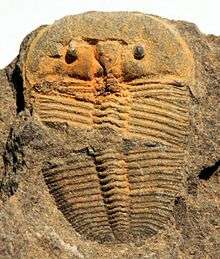Aulacopleura
Aulacopleura is a genus of proetid trilobite that lived from the Middle Ordovician to the Middle Devonian. The cephalon is semicircular or semielliptical, with border and preglabellar field. The glabella is short, with or without defined eye ridges connecting it with eyes of variable size. Spines at the rear outer corners of the cephalon (or genal spines) are present, typically reaching back to the 2nd to 4th thorax segment. The 'palate' (or hypostome) is not connected to the dorsal shield of the cephalon (or natant). The cephalon is pitted, or has small tubercles. The thorax has up to 22 segments. The pleural ends are usually rounded. The pygidium is small (micropygous), with an even margin.
| Aulacopleura | |
|---|---|
 | |
| Aulacopleura konincki, Kosovu Beruna, Czech Republic | |
| Scientific classification | |
| Kingdom: | Animalia |
| Phylum: | Arthropoda |
| Class: | †Trilobita |
| Order: | †Proetida |
| Family: | †Aulacopleuridae |
| Genus: | †Aulacopleura Hawle & Corda, 1847 |
| Type species | |
| A. konincki Barrande, 1846 | |
| Species | |
| |
| Synonyms | |
|
Arethusa Barrande, 1846 non De Montfort, 1808, Arethusina Barrande, 1852 | |
Taxonomy
Barrande described Arethusa konincki in 1846. However, Arethusa was occupied since it was used by De Montfort in 1808 for a foram protist.[1]
Distribution
- A. konincki (A. koninckii[2] seems to be misspelled) is known from the Middle Silurian of the Czech Republic (Wenlockian, Liten Formation, Bohemia).
- A. letmathensis has been found in the Middle Devonian of Germany (Givetian).
- A. pogsoni was collected from Lower Silurian of Australia (late Llandovery, upper Cotton Formation, near Forbes, New South Wales).
- A. wulongensis occurs in the Lower Silurian of China (Llandovery, Sichuan).[3]
See also
- List of trilobites
- Trilobite Terminology
References
- B. W. Hayward: Arethusa Montfort, 1808 †, on: World Foraminifera Database, marinespecies.org, Flanders Marine Institute
- Brigitte Schoenemann, Euan N. K. Clarkson: Insights into a 429-million-year-old compound eye, in: nature, Scientific Reports 10, Article number: 12029 (2020), doi:10.1038/s41598-020-69219-0.
Michael Marshall: Trilobites living 429 million years ago had eyes like modern insects, on: NewScientist, 13 August 2020 - Edgecombe, G.D.; Sherwin, L. (2001). "Early Silurian (Llandovery) trilobites from the Cotton Formation, near Forbes, New South Wales, Australia". Alcheringa: An Australasian Journal of Palaeontology. 25 (1): 87–105). doi:10.1080/03115510108619215.